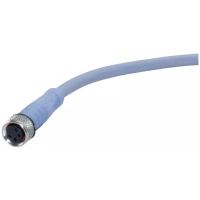20: P
ULSE
I
NSTRUCTIONS
« FC4A M
ICRO
S
MART
U
SER
’
S
M
ANUAL
» 20-13
RAMP (Ramp Control)
Note:
The RAMP instruction can be used only once in a user program. When RAMP is used with reversible control disabled,
unused output Q1 can be used for another pulse instruction PULS2, PWM2, or ZRN2 or ordinar y output.
Applicable CPU Modules
Valid Operands
Source operand S1 (control register) uses 11 data registers starting with the operand designated as S1. Data registers D0
through D1289 and D2000 through D7989 can be designated as S1. For details, see the following pages.
Destination operand D1 (status relay) uses 4 internal relays starting with the operand designated as D1. Internal relays M0
through M1270 can be designated as D1. The least significant digit of the internal relay number designated as D1 must be
0, otherwise the RAMP instruction does not operate correctly. Special internal relays cannot be designated as D1. For
details, see page 6-2.
Source Operand S1 (Control Register)
Store appropriate values to data registers starting with the operand designated as S1 before executing the RAMP instruc-
tion as required, and make sure that the values are within the valid range. Operands S1+8 through S1+10 are for read only.
FC4A-C10R2/C FC4A-C16R2/C FC4A-C24R2/C FC4A-D20K3/S3 FC4A-D20RK1/RS1 & FC4A-D40K3/S3
——— X X
Operand Function I Q M R T C D Constant Repeat
S1 (Source 1) Control register —————— X — —
D1 (Destination 1) Status relay — — X ———— — —
Operand Function Description R/W
S1+0 Operation mode
0: 10 to 1,000 Hz
1: 100 to 10,000 Hz
2: 1,000 to 20,000 Hz
3: 10 to 20,000 Hz (upgraded CPU only)
R/W
S1+1 Steady pulse frequency
When S1+0 (operation mode) = 0 or 1: 1 to 100 (%)
(1% to 100% of the maximum frequency of selected mode S1+0)
When S1+0 (operation mode) = 2: 1 to 20 (×5%)
(5% to 100% of the maximum frequency of selected mode S1+0)
When S1+0 (operation mode) = 3: 10 to 20,000 (Hz)
R/W
S1+2 Initial pulse frequency
When S1+0 (operation mode) = 0 or 1: 1 to 100 (%)
(1% to 100% of the maximum frequency of selected mode S1+0)
When S1+0 (operation mode) = 2: 1 to 20 (×5%)
(5% to 100% of the maximum frequency of selected mode S1+0)
When S1+0 (operation mode) = 3: 10 to 20,000 (Hz)
R/W
S1+3
Frequency change rate
When S1+0 (operation mode) = 0 or 1: 1 to 100 (%)
(1% to 100% of the maximum frequency of selected mode S1+0)
When S1+0 (operation mode) = 2: 1 to 20 (×5%)
(5% to 100% of the maximum frequency of selected mode S1+0)
R/W
Frequency change time When S1+0 (operation mode) = 3: 10 to 10,000 (ms)
source operand S1. After starting the RAMP instruction, the output pulse fre-
at this value for some time, and then decreases linearly to the original value.
acceleration and deceleration of the movement.

